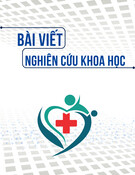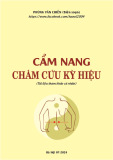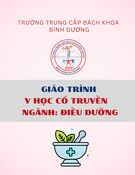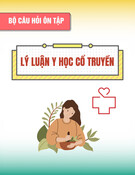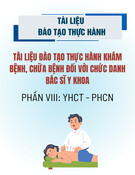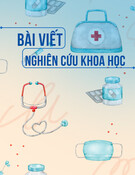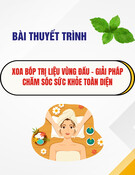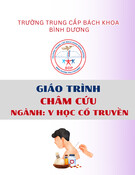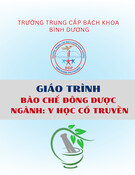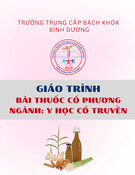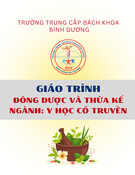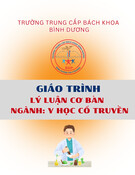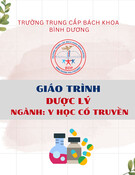
112 Hoa Binh University Journal of Science and Technology - No 14 - 12.2024
PHARMACEUTICALS
FIFTY-ONE VIETNAMESE TRADITIONAL MEDICINES DERIVED
FROM INVERTEBRATE ARTHROPDS (ARTHROPODA) AND
ANNELIDS (ANNELIDA)
Prof. D. Sc. Vu Quang Manh1, Specialist pharmacist I. Pham Thi Xuan1,
Assoc. Prof., Dr. Le Thanh Long2, MA. Tran Bui Phuc3
1Hoa Binh University
2Institute of Tropical Biology
3Nguyen Tat Thanh University
Corresponding Author: vqmanh@gmail.com
Received: 01/12/2024
Accepted: 10/12/2024
Published: 24/12/2024
Abstract
To develop the Bio-pharmacology major at the university level, a comprehensive survey of
invertebrate arthropods (Arthropoda) and annelids (Annelida) utilized as Vietnamese traditional
medicines was conducted. The survey was organized according to six criteria: (1) Vietnamese and
medicinal name, (2) classification and scientific name, (3) distribution and habitat, (4) medicinal
properties, (5) pharmaceutical effects, (6) discussion and comments.
A total of fifty-one invertebrate species were identified, comprising forty-six arthropod species and
five annelid species used in traditional medicine. Among these, the phylum Arthropoda includes four
classes (Insecta, Arachnida, Chilopoda, Diplopoda), seventeen orders and forty-six species species.
The phylum Annelida comprises four classes (Oligochaeta, Polygochaeta, Hirudinea, Sipunculidae),
five orders, and five species. According to class, the number of species used in traditional medicines
decreases as follows: Insecta is the most numerous, followed by Diplopoda and Oligochaeta, each
represented by two orders and two species. The four classes Chilopoda, Polygochaeta, Hirudinea and
Sipunculidae each have one order and one species.
Insecta is the class with the dominant species number, used in traditional Vietnamese medicines,
with 40/51 species, accounting for 78.43%. The distribution of insect species across increasingly
orders is as follows: Thysanura = Mantoptera = Termites = Isoptera = Diptera = Siphonaptera, all
have 1 species. Then the orders Odonata = Blattoptera = Lepidoptera, all have 2 species, and the
Orthoptera = Hemynoptera, all have 5 species. The Hemiptera and Coleoptera have the most species,
with 9 and 11 species, respectively. Notably, the species giant water bug Lethocerus indicus, has been
listed in the Vietnam Red Data Book since 1992. This highlights the necessity to adhere to Vietnam's
diversity laws when exploiting and using these species.
Năm mươi mốt bài thuốc truyền thống Việt Nam có nguồn gốc từ động vật không xương sống
Chân khớp (Arthropoda) và Giun đốt (Annelida)
GS.TSKH Vũ Quang Mạnh1, DSCKI. Phạm Thị Xuân1,
PGS.TS Lê Thành Long2, ThS. Trần Bùi Phúc3
1Trường Đại học Hòa Bình
2Viện Sinh học Nhiệt đới
3Trường Đại học Nguyễn Tất Thành
Tác giả liên hệ: vqmanh@gmail.com

No 14 - 12.2024 - Hoa Binh University Journal of Science and Technology 113
PHARMACEUTICALS
Tóm tắt
Nhằm phát triển Bộ môn “Sinh dược học” ở bậc đại học, khảo sát tổng quan về động vật không
xương sống Chân khớp (Arthropoda) và Giun đốt (Annelida) được thực hiện. Chúng được khảo sát
theo 6 tiêu chí (1) Tên Việt Nam và bài thuốc, (2) Hệ thống phân loại và tên khoa học, (3) Phân bố
và môi trường sống, (4) Vị thuốc, (5) Tác dụng y dược học, (6) Thảo luận và nhận xét.
Đã xác định được năm mươi mốt loài động vật không xương sống gồm 46 loài Chân khớp
(Arthropoda) và 5 loài Giun đốt (Annelida), được sử dụng trong các bài thuốc truyền thống Việt
Nam. Trong đó, Arthropoda có 4 lớp (Insecta, Arachnida, Chilopoda, Diplopoda), với 17 bộ và 46
loài; và Annelida có 4 lớp (Oligochaeta, Polygochaeta, Hirudinea, Sipunculidae), với 5 bộ và 5 loài.
Theo lớp động vật, số lượng loài giảm dần như sau: nhiều nhất là Insecta; tiếp đến là Arachnida với 2
bộ và 3 loài; và Diplopoda và Oligochaeta, đều có 2 bộ và 2 loài. Bốn lớp Chilopoda, Polygochaeta,
Hirudinea và Sipunculidae đều có 1 bộ và 1 loài.
Côn trùng là lớp có số lượng loài ưu thế trong nhóm động vật không xương sống sử dụng trong
các bài thuốc y học cổ truyền Việt Nam, với 40/51 loài, chiếm 78,43%. Số lượng loài côn trùng sử
dụng làm thuốc ở các bộ tăng dần theo thứ tự sau: các bộ Thysanura = Mantoptera = Isoptera =
Diptera = Siphonaptera, đều có 1 loài. Tiếp đến là các bộ Odonata = Gián Blattoptera = Cánh
phấn Lepidoptera, đều có 2 loài. Rồi các bộ Orthroptera = Hemynoptera, đều có 5 loài. Bộ Cánh
nửa Hemiptera và Coleoptera có nhiều loài nhất, tương ứng có 9 và 11 loài. Trong đó, loài cà cuống
Lethocerus indicus có tên trong Sách Đỏ Việt Nam (1992). Cần chú ý khi khái thác và sử dụng đúng
luật “Đa dạng Sinh học của Việt Nam”.
1. Introduction
Vietnam is among the top 20 countries with
the highest biodiversity resources in the world.
Our country is ranked 14th in the World, with a
biodiversity index of 221.77. Our country is in
the top three Southeast Asian countries in terms
of biodiversity, behind Indonesia and above
Malaysia (Vietnamnet).
Vietnam's rich biodiversity resources are
also reflected in the use of this rich source of
raw materials in traditional medicines (Van, Tap
2008). The use of Arthropods and Annelids in
traditional Vietnamese medicines has a long
history, accumulating many approaches and rich
experiences for thousands of years. However,
the use of animal resources in traditional
medicines or therapies, in some cases, is often
based on oral habits and experiences, without
full information on medicinal preparation
methods. In particular, in many cases there
is no morphological description and exact
scientific name of invertebrate. From the aspect
of exploitation and conservation of sustainable
development of animal resources, their accurate
identification and naming is an important initial
basis for use in traditional Vietnamese medicine.
This overview survey was conducted to
comprehensively investigate animal resources,
describe, identify and accurately scientifically
name the invertebrate animals used in traditional
Vietnamese medicines. This is an important
initial scientific data, serving as a basis for
building a subject Bio-Pharmacology in the field
of Medicine and Pharmacy, on the biodiversity
of animal resources and their use in traditional
Vietnamese medicines.
2. Approach Method
The authors used accessible domestic and
international sources on traditional Vietnamese
herbal medicines to survey invertebrates

114 Hoa Binh University Journal of Science and Technology - No 14 - 12.2024
PHARMACEUTICALS
commonly used in traditional Vietnamese
medicines. These are documents of Chi (1998),
Loi (1999), Quy, Phuong (2002), Institute of
Medicinal Materials (2006), Ministry of Health
(2017), Tianren Xu et al. (2022), etc.
Many national and international specific
documents on particular invertebrate animals
and species, such as of Tieu (1928); Manh, et
al. (2007); Hue, et al. (2009) ; Thai, et al. (2009) ;
Manh, Thin (2009); Huang Y. et al. (2016); Tung,
et al. (2016); Ministry of Health (2017); Manh,
et al. (1992, 2015, 2022); Phuong, et al. (2022),
Phommavongsa, et al. (2022); MilliBase (2024).
3. Result and discussion
3.1. Arthropods (Arthropoda) and Annelids
(Annelida) resources used in Vietnmamese
traditional medicines
Table 1 presents the results of the analysis
of arthropod and annelid invertebrates used in
traditional Vietnamese medicines. In this table,
invertebrates were surveyed according to 6
criteria including (1) Vietnamese and medicinal
name, (2) classification and scientific name, (3)
distribution and habitat, (4) medicinal properties,
(5) pharmaceutical effects, (6) discussion and
comments (Table 1).
Table 1. Arthropoda and Annelida Resources Used in Vietnmamese Traditional Medicines
No Vietnamese names Scientific names and
Classification
Distribution,
Habitat
Medicinal
properties Medicinal effects
1
Silverfis
= Bọ bạc
= Nhạy
= Rệp sách
= Y ngư.
1. Lepisma saccharina (Linnaeus 1758).
Insecta -Apterygota.
I. Order - Bộ Ba đuôi - Zygentoma =
Thysanura),
Họ - Family Lepismatidae.
Usually lives in old
damp books, cellulose
papers.
Salty taste,
warm property
Diuretic, anti-wind, detoxifying.
Treats hematuria, bright-ens eyes.
Treats children with con-vulsions
and itch-ing.
2
Dragonfly Anax
imperator
= Chuồn chuồn ngô
= Thanh đình.
2. Anax parthenope (Selys, 1839).
Insecta - Pterygota.
II. Bộ Chuồn chuồn - Order Odonata,
Họ - Family Aeshnidae.
Cosmpolites. Usually
lives in wet grassland
habitat, near water.
Sweet taste,
slightly cold.
Treats whooping cough, sore throat
and pharynx, asthma due to kidney
failure. Treats spermatorrhea and
impotence.
3
Red dragonfly
= Chuồn chuồn đò
= Xích thanh linh.
3. Crocothemis servillia (Drury
1773).
II. Bộ - Order Chuồn chuồn -Odonata,
Họ - Family Chuồn ớt - Libellulidae.
Usually lives in wet
grassland habitat, near
water.
Sweet taste,
slightly cold.
Blood tonic, cures headaches due
to anemia, dizziness, whooping
cough, swollen throat. Kidney tonic,
spermatorrhea, impotence treatment.
4
Oriental cockroach
= Gián nhà
= Chương lang.
4. Blatta oirienỉalis (Linnaeus 1758).
III. Bộ Gián - Order Blattoptera.
Họ - Family Gián nhà - Blattidae.
Usually lives in moist
and dark habitats, near
to hmans. Active at
night.
Slightly sweet
taste, slightly
fishy smell,
toxic.
It has the effect of promoting blood
circulation, elimi-nating phlegm,
diu-retic, detoxifying.
Treats stomach pain, respiratory
diseases and some other diseases.
5
Chinese medicinal
cockroach
= Gián đất
= Địa biết.
5. Eupolyphaga sinensis (Walker
1868).
III. Bộ Gián - Order Blattoptera
Họ - Family Gián đất - Corydiidae.
Usually lives in
topsoil and forest
litter.
Salty taste, cold
nature.
It has the effects of promoting blood
circulation, dispersing stagnation,
reducing swelling, and relieving
pain. It treats tumors and postpartum
blood stasis
6
- European mantis
- Mulberry tree
mantis nest
= Bọ ngựa
= Đường lang.
= Tổ bọ ngựa cây dâu
= Tang phiêu tiêu.
6. Mantis religiosa (Linnaeus, 1758).
IV. Bộ Bọ ngựa - Order Mantoptera
Họ - Family Bọ ngựa - Mantidae.
Usually lives on
shrubs and low trees.
Sweet and salty
taste, slightly
fishy, moist and
normally non-
toxic.
Treats night sweats, frequent urination
at night, bedwetting in children,
incontinence in the elderly and
amenorrhea in women.
Helps cure sore throat, hemorrhoids,
epilepsy, convulsions. Kidney tonic,
cure premature ejaculation, impotence.
7
Small rice
grasshopper
= Châu chấu hại lúa
= Hoàng trùng.
7. Oxya chinensis (Thunberg 1815).
= Oxya sinuosa Mishchenko, 1951
= Oxya lobata Stål, 1877 = Gryllus
chinensis Thunberg 1815.
V. Bộ Cánh thẳng - Order Orthoptera.
Họ Châu chấu - Family Grasshopper
- Acrididae.
Usually lives in
habitats of land
growing food crops
and food plants.
Sweet and spicy
taste, neutral
and warm.
Effects: cough and asthma relief,
tonic, penetrating.
Treats children with epilepsy,
whooping cough, and prevents
measles from growing.

No 14 - 12.2024 - Hoa Binh University Journal of Science and Technology 115
PHARMACEUTICALS
8
Yellow-spined
Bamboo Locust
= Châu chấu tre lưng
vàng.
8. Ceracris kìangsu, Tsai 1929.
V. Bộ Cánh thẳng - Order Orthoptera.
Họ Châu chấu - Family Acrididae.
Usually lives in
secondary habitats,
with bamboo bushes.
Cough suppressant, asthma
suppressant, sedative and detoxifying
effects.
Treat children with whooping cough,
asthma, epilepsy.
9
African mole cricket
= Dế trũi
= Dế dụi
= Dế nhủi.
9. Gryllotalpa africana (Palisot de
Beauvois, 1805).
V. Bộ Cánh thẳng - Order Orthoptera.
Họ Dế trũi - Family Gryllotalpidae.
It is distributed all
over temperate and
tropical regions of
Africa, Europe,
Australia Asia.
Salty taste, cold
nature, non-
toxic.
Helps with urination, frequent and
painful urination, eliminates kidney
stones. Treats body aches, relieves
headaches, and removes thorns.
Has the effect of curing "cirrhosis of
the liver".
10
The Chinese cricket
= Dế mèn nhỏ.
10. Gryllus chinensis (Weber 1801).
= Eumodicogryllus chinensis (Weber,
1801).
V. Bộ Cánh thẳng - Order Orthoptera.
Họ Dế mèn - Family Gryllidae
Usually lives in holes
in moist topsoil.
Salty taste, cold,
non-toxic.
Treats urinary retention, edema,
promotes urination and defecation;
induces labor.Treatment for mothers
with placenta not coming out and
constipation.
11
Rice field cricket,
= Brown field cricket
= large brown cricket
= Dế mèn lớn
11. Tarbinskiellus portentosus
(Lichtenstein, 1796)
= Gryllus (Acheta) achatinus (Stoll,
1813).
= Brachytrupes ustulatus (Serville,
1838).
= Liogryllus formosanus (Matsumura,
1910).
V. Bộ Cánh thẳng - Orthoptera, họ Dế
mèn - Gryllidae.
Usually lives in non-
flooded food crop
fields.
Spicy, salty,
warm and toxic.
Anti-inflammatory effect.
12
Lychee giant stink
bug
= Bọ xít nâu
= Bọ xít hại nhãn vải.
12. Tessaratoma papillosa (Drury,
1770).
VI. Bộ Cánh nửa –Order Hemiptera.
Họ Bọ xít nhãn -Family
Tessaratomidae.
Parasites suck sap on
longan and lychee
fruit trees. Both larvae
and adults parasitize
the tree.
Effects of activating blood
circulation, reducing swelling and
pain.
13
Southern green stink
bug
= Bọ xít xanh
= Bù hút cam.
13. Nezara viridula (Linnaeus, 1758)
= Cimex smaragdulus Fabricius,
1775.
= Nezara approximata Reiche,
Fairmaire, 1848.
VI. Bộ Cánh nửa – Order Hemiptera.
Họ Bọ xít cam - Family
Pentatomidae.
Mainly damages citrus
fruit trees, such as
oranges, tangerines,
and lemons.
No data Effects of activating blood
circulation, reducing swelling and
relieving pain; reducing blood stasis
and swelling.
14
Bedbugs
= Rệp
= Bích sắt hay sàng
sắt
14. Cimex lectularius (Linnaeus 1758)
Nhóm động vật hút máu -
Bloodsucking animals -Hematophagy.
VI. Bộ Cánh nửa –Order Hemiptera.
Family Cimicidae.
Live near people,
in crevices between
beds, mats and
mattresses.
Spicy taste,
warm nature.
Treats choking, epilepsy in children;
eyes with entropion or smooth eyelid
growth.
Cure urinary retention, leg ulcers,
centipede bites.
15
Giant water bug-1
= Cà cuống-1
= Đà cuống
= Rận rồng/
= Long sắt.
= Sâu quế
15. Lethocerus indicus (Lepeletier et
Serville, 1775)
= Belostoma indica Vitalis.
VI. Bộ Cánh nửa - Order Hemiptera.
Họ Chân bơi - Family
Belostomatidae.
Lives in aquatic
habitats, rice fields or
small water shrubs.
It has been recorded in
the whole of Vietnam.
Sweet and spicy
taste, neutral
and non-toxic.
Kidney tonic and yang tonic effects,
creating excitement outside the
genitals.
Stimulates appetite and aids
digestion.
16
Giant water bug-2
= Cà cuống -2
16. Lethocerus deyrollei (Vuillefroy,
1864)
= Kirkaldyia deyrollei (Vuillefroy,
1864)
VI. Bộ Cánh nửa - Order Hemiptera.
Họ Chân bơi - Family
Belostomatidae.
Lives in aquatic
habitats, rice fields or
small water shrubs.
Its distribution was
restricted only in
the Central area of
Vietnam.

116 Hoa Binh University Journal of Science and Technology - No 14 - 12.2024
PHARMACEUTICALS
17
Cicadas
= Ve sầu
= Trách thiền
= Kim thuyền.
17. Cryptotympana japonensis Kato,
1925.
VI. Bộ Cánh nửa - Order Hemiptera
(+Cánh giống - Homoptera).
Họ Ve sầu - Family Cicadidae.
Widely distributed.
Adults live attached
to and suck green
plant sap. Larvae
live in soil; larval
development in soil
can last for many
years.
Odorless,
bland taste.
The medicinal
properties of
the medicine
are light, thin,
hollow, and
easily broken.
Treats colds, bronchitis, hoarseness;
new pimples on the head and face.
Treat vestibular disorders,
headaches, dizziness, tinnitus.
Treatment of albuminous urine, body
edema due to chronic nephritis.
18
Lac Insect
= Cánh kiến đỏ
= Rệp son
= Từ thảo nhung
= Tử giao
= Xích giao
= Tử trùng giao.
18. Kerria lacca (Kerr, 1782)
= (?) Lacccifer lacca chinensis
Mahdihassan, 1923.
VI. Bộ Cánh nửa - Order Hemiptera
(+Cánh giống - Homoptera), họ Cánh
kiến đỏ - Laccifridae.
Usually lives in
mountainous areas of
Vietnam, 500-700m
above sea level; grows
on host trees,
Thường sống ở vùng
rừng núi Việt Nam,
500-700m trên mặt
biển; phát triển trên
cây chủ.
Bitter taste, cold
nature.
Helps clear heat, detoxify, promote
blood circulation, stop bleeding, treat
acne and scabies.
Treatment of amenorrhea and
postpartum hemorrhage.
Helps prevent and treat tooth decay.
19
Chinese sumac aphid
= Sâu muối
= Ngũ bội tử
= Bơ pật
= /Bách trùng
thương.
-Tổ của sâu ngũ bội
tử.
19. Schlechtendalia chinensis (Bell,
1851).
VI. Bộ Cánh nửa - Order Hemiptera.
Họ Rệp muội - Family Aphididae
Living commensally
on salt trees
(Rhus chinensis,
Anacardiaceae,
Sapindales), forming
nests in young
branches or leaf
petioles.
Sour taste,
neutral
properties,
enters three
meridians: lung,
kidney, large
intestine.
Effects of lung-clearing, fire-
reducing, hemostatic, perspiration-
suppressing, intestinal-tightening;
hemostasis by coagulation, and
alkaloid detoxification.
Treats cough due to lung deficiency,
external hemorrhoids due to long-
term dysentery, diarrhea, bloody
dysentery, liver detoxification,
sweating, acne.
20
Insect Epicauta
= Ban miêu đen, sọc
trắng, dọc thân.
= Sâu đậu
= Nguyên thanh
= Ban mao.
20. Epicauta gorhami (Marseul, 1873)
VII. Bộ Cánh cứng - Order Coleoptera.
Họ Ban miêu - Family Meloidae.
Usually lives on food
plants, low bushes.
Spicy, hot, toxic. Treat amenorrhea, dysmenorrhea,
acne, inhibit tumors. Used as a skin
blister medicine, to lead poison; treat
sore throat, cough with phlegm for
many years.
21
Meloid Mylabris
= Ban miêu đỏ ba
sọc đen đậm, ngang
thân
21. Mylabris phalerata (Pallas, 1781).
VII. Bộ Cánh cứng - Order
Coleoptera.
Họ Ban miêu - Family Meloidae.
Usually lives on food
plants, low bushes
(Fabaceae).
Spicy, cold, and
toxic. Salty,
negative.
Effect of expelling stasis and
breaking up clots. Treating syphilis,
poisonous epidemics, and rabid dog
bites.
22
Scarabeid Lepidiota
=Bọ dừa
22. Lepidiota bimaculata (Saunders,
1839).
VII. Bộ Cánh cứng - Order
Coleoptera.
Họ Bọ hung - Family Scarabaeidae.
Live on tree trunks. Undetermined. Cure stomach ache.
23
Scarabeid Bug, male
only
=Bọ hung
=Khương lang, cá
thể đực.
23. Catharsius molossus (Limaeus
1756)
VII. Bộ Cánh cứng - Order
Coleoptera.
Họ Bọ hung - Family Scarabaeidae.
Usually lives in the
dung of grazing
animals, such as
buffalo, cows, goats,
horses, and sheep.
Salty taste, cold
nature, toxic.
Treats dysmenorrhea, hemoptysis,
and stasis. Treats dysmenorrhea,
breaks up stasis, and clears bowels.
24
Firefly Luciola
= Đom đóm
= Huỳnh hoả.
24. Luciola vitticollis (Kiesenwetter,
1874)
VII. Bộ Cánh cứng - Order
Coleoptera.
Họ Đom đóm - Family Lampyridae.
Usually lives in
humid habitats of
forest edges, bushes,
gardens, fields.
Spicy and salty
taste, slightly
warm, cold,
non-toxic.
Detoxifying, anti-inflammatory,
antiseptic, treats acne in children.
Cure ghost spells (fake death
and fainting), blurred vision, and
paralysis.
25
Bombardier beetle
= Bọ thẹt
= Bọ phịt
= Bọ nổ bom.
25. Pheropsophus jessoensis (A.
Morawitz, 1862)
VII. Bộ Cánh cứng - Order
Coleoptera.
Họ Chân chạy - Family Carabidae.
Usually lives in leaf
litter, topsoil, under
rocks and trees.
Undetermined. Effect of activating blood circulation,
removing blood stasis and
eliminating perforation.
Cure abdominal pain, neck pain.

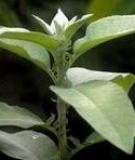

![Hoa chữa bệnh tiểu đường: [Loại hoa] tốt nhất, kinh nghiệm sử dụng](https://cdn.tailieu.vn/images/document/thumbnail/2010/20101125/nhochongnhieu/135x160/31_3739.jpg)


